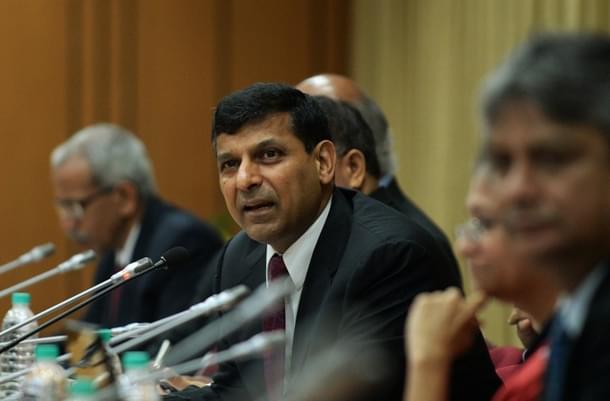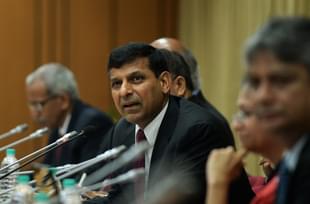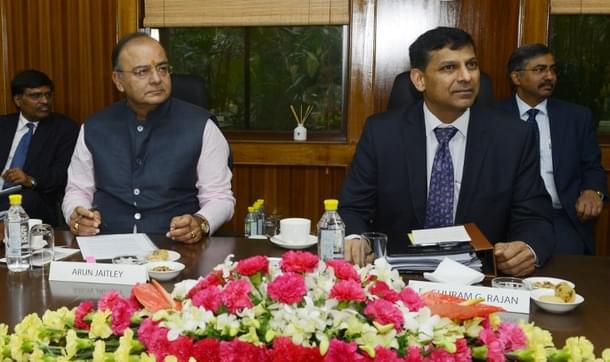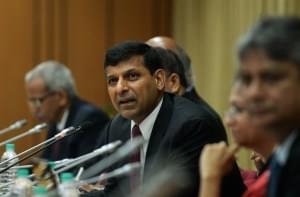Economy
Repo Rate Cut - Why The RBI Did It Now
Sunil S Bhandare
Oct 01, 2015, 06:01 PM | Updated Feb 11, 2016, 09:04 AM IST
Save & read from anywhere!
Bookmark stories for easy access on any device or the Swarajya app.


The RBI Governor has strategically managed the timing of the bold monetary policy easing. The ball is squarely now in the government’s domain to push ahead with the pending reforms agenda.
The Reserve Bank of India’s bold move to cut the key policy rates by as much as 50 basis points is being looked upon as a wonderful Diwali gift, especially for borrowers. Most of them have been groaning that high interest rates are hurting their competitiveness, profitability and new investments.
To recap, the key elements of the Fourth Bi-Monthly Monetary Policy are:
– A reduction in the repo rate (rate at which banks borrow funds from the RBI against eligible collateral) to 6.75 per cent, reverse repo (the rate at which banks place their surplus funds with the RBI) rate to 5.75 per cent, and marginal standing facility or MSF rate (access to additional liquidity requirements of banks by way of overnight funds from the RBI)/ bank rate to 7.75 per cent.
= Cash reserve ratio (CRR) of banks is unchanged at 4 per cent
– The existing liquidity support system is being continued
With these changes, the key interest rates scenario is now back to its previous lowest level of March 17, 2011. Incidentally, the consumer price index (CPI) inflation rate then was around 6 per cent while the latest data for August 2015 shows it at a much comfortable 3.7 per cent level.

The Rationale
There are several trigger points for the RBI’s “big-bang” cutback in key policy rates, quite apart from the constant nudges from the finance ministry. Its assessment of both existing and emerging global and domestic economic scenario also unfolds several daunting challenges that the Indian economy will have to deal with.
First, the external outlook is bleak, with moderation of global growth, further deterioration in global trade and increased downside risks to growth. Not only are the advanced economies still grappling with growth recovery, but even emerging market economies are seeing slower global trade volumes, depressed commodity prices, weakening currencies and capital outflows.
There are disturbing trends in the BRICS (Brazil, Russia, India, China, South Africa) countries as well. China is trying to shift focus from investment towards consumption, has seen a stock market meltdown, slower industrial production, weaker exports, and the recent mild devaluation of the renminbi unsettled global financial markets. Brazil and Russia facing recession and runaway inflation and South Africa is facing structural constraints, threatening to tip it into a downturn.
Second, the RBI notes that the Indian scenario is characterized by “a tentative economic recovery” which “is still far from robust”. Rural demand remains subdued, the manufacturing sector has exhibited uneven growth, there are challenges of weaker external demand conditions accompanied by cheaper imports due to global overcapacity. This is contributing to continuing domestic capacity under-utilization, decelerating new orders and a rising ratio of finished goods inventories to sales.
In substance, since the RBI has now gained some greater confidence on inflation management (its inflation projection of 5.8 per cent by January 2016 is a shade lower than the earlier projection), it is now willing to shift its goalpost more aggressively towards improving the investment outlook and promoting growth. It has found the space for the monetary policy to work strategically towards longer-term objective of stable, sustainable high growth.
Investment and Growth Outlook
Apart from the RBI’s upfront action on easing of key policy rates, the emerging interest rate scenario is also going to be positively impacted by two other policy initiatives – a significant increase in the investment quota in government securities released for foreign portfolio investor (FPI); and prospective changes in the statutory liquidity ratio (SLR).
Both these will help ease liquidity in the financial markets. There would also be a favourable spin off coming from the government’s success in its fiscal consolidation efforts as well as gradual reduction in the cost of government borrowings, leading to the reduction in the interest payments bill.
The extent of the positive impact of the rate cut would undoubtedly be determined by the efficiency of transmission mechanism. Some banks have already announced a 25 to 40 basis points reduction in their base rate. Over the last nine months, the cumulative fall in banks’ lending rates would be about 60 to 75 basis points. This should reduce the cost of capital to borrowers and improve their profit margins by 15 to 20 basis points, provided, of course, there are not going to be any countervailing cost increases for corporate and non-corporate borrowers.
Banks are invariably found to be prompt in reducing deposit rates in step with reduction in key policy rates, but are generally slow and halting in reducing lending rates. Bank depositors are surely going to be at the receiving end. An imminent full-fledged reduction in deposit rates by 50 basis points on top of the 75-100 basis points reduction that depositors have already suffered over the past nine months, would seriously impair their nominal interest income. A crude calculation suggests that, on an annualised basis, banks would be able to save about Rs 16,500 crore in interest cost on new and renewal deposits. This is the extent of interest income loss to depositors. In turn, this would have some constraining impact on their consumption demand at least in the short-run.
Will this be more than made good by a stimulus to overall investment activity and demand for manufactured goods and construction sector, including real estate? These are the sectors where the economy desperately seeks substantial incremental growth drivers. But at this stage, we can make our guess based only on the warm acclaim that the policy has received from spokespersons of various industrial and business sectors.
At this stage, the impact of interest rate softening would be more by way of a psychological booster rather than an instant stimulus to production and investment activities. Indeed, the RBI’s own economic assessment concludes by suggesting that “with global growth and trade slower than initial expectations, a continuing lack of appetite for new investment in the private sector, the constraint imposed by stressed assets on bank lending and waning business confidence, output growth projected for 2015-16 is marked down slightly to 7.4 per cent from 7.6 per cent earlier.”

Effectively, the monetary policy indirectly suggests that in the absence of its bold move to reduce policy rates, real GDP growth rate would perhaps be even lower than 7.4 per cent. Thus, for all practical purposes, the monetary policy per se does not improve the growth outlook for the current financial year, albeit it would pave the way for India’s higher growth trajectory going forward.
Now that the RBI has front-loaded its policy action, the ball is squarely in the court of the government as well as with business and industry. The RBI would obviously like to see “continuing policy implementation, structural reforms and corporate actions leading to higher productivity” to provide the primary impetus for sustainable growth. But there is obviously a waiting period for that to happen.
Exchange Rate Prospects
There was considerable turmoil in India’s currency markets around mid-August following the devaluations of the Chinese renminbi. The Indian rupee depreciated by about 4 per cent between early August and now. In recent times, it has been fluctuating in a band of US$ = Rs.66 + 50 paise/-25 paise. Whether this is an appropriate exchange rate or not is difficult to judge. What is, however, important to stress are the market worries about the capital outflows as and when the US Fed resumes its cycle of interest rate hikes.
However, the monetary policy seems to have taken some clever initiatives of enhancing foreign portfolio investors’ (FPIs) quota for investment in government securities. This would help in mobilising foreign funds. More importantly, India’s current account deficit to GDP ratio and overall balance of payments scenario looks very comfortable, albeit it is a reflection of low level equilibrium. Further, the RBI is also adequately equipped given the present forex reserves of around US$352 billion, equivalent of over eight months’ imports. In substance, the exchange rate can be effectively calibrated by the strength and quality of support which the economy has now come to acquire.
The RBI Governor has strategically managed the timing of the bold monetary policy easing. His approach is based on sound rationale; his policy instruments are well refined; his assessments of global and domestic economic scenario are well-balanced; and his commitment to the cause of stable inflation environment for steady and healthy growth acceleration is unequivocal.
The ball is squarely now in the government’s domain to progress with the pending reforms agenda. Finally, corporate and non-corporate businesses and industry can no longer grumble that nothing is happening at the ground level!
Sunil S. Bhandare is a consulting economist and former economic advisor to the Tata Group.





